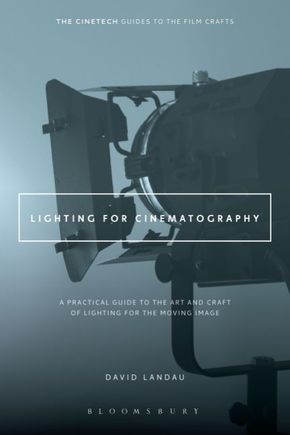
Lighting for Cinematography - A Practical Guide to the Art and Craft of Lighting for the Moving Image
| Verlag | Bloomsbury Academic |
| Auflage | 2014 |
| Seiten | 288 |
| Format | 18,6 x 23,5 x 1,4 cm |
| Gewicht | 760 g |
| Artikeltyp | Englisches Buch |
| Reihe | The CineTech Guides to the Film Crafts |
| ISBN-10 | 1628926929 |
| EAN | 9781628926927 |
| Bestell-Nr | 62892692UA |
A how-to book on the art, craft and practice of lighting for film & video for students and filmmakers.
Klappentext:
We can't shoot good pictures without good lighting, no matter how good the newest cameras are. Shooting under available light gives exposure, but lacks depth, contrast, contour, atmosphere and often separation. The story could be the greatest in the world, but if the lighting is poor viewers will assume it's amateurish and not take it seriously. Feature films and TV shows, commercials and industrial videos, reality TV and documentaries, even event and wedding videos tell stories. Good lighting can make them look real, while real lighting often makes them look fake.
Lighting for Cinematography, the first volume in the new CineTech Guides to the Film Crafts series, is the indispensable guide for film and video lighting. Written by veteran gaffer and cinematographer David Landau, the book helps the reader create lighting that supports the emotional moment of the scene, contributes to the atmosphere of the story and augments an artistic style. Structured to mimic a 14 week semester,the chapters cover such things as lighting for movement, working with windows, night lighting, lighting the three plains of action and non-fiction lighting. Every chapter includes stills, lighting diagrams and key advice from professionals in the field, as well as lighting exercises to help the reader put into practice what was covered.
www.lightingforcinematography.com
Inhaltsverzeichnis:
Contents
Acknowledgements
Introduction: No matter how good a camera, good lighting is what sells the picture
Chapter 1: The Magic of Light - What lighting does for the image and what light is.
Chapter 2: Who and What Makes Light- the lighting crew, lighting units, basic electricity
Chapter 3: Lighting the Subject - motivated and three point lighting
Chapter 4: Light the shot, not just the subject - three plains of lighting
Chapter 5: Common Practical Lighting Set-ups - cross key, chicken coop, china ball, bathrooms
Chapter 6: Lighting for Movement - subject & camera, ambient soft light
Chapter 7: Dealing with Daylight 1: Shooting Exteriors
Chapter 8: Dealing with Daylight 2: Working with windows
Chapter 9: Night Light- lighting night exteriors & interiors
Chapter 10: Working with Color - using color for mood, gels
Chapter 11: Light the scene, not just the shot - High Key, Low Key, contrast ratios, exposure choice, Chiaroscuro lighting, Rembrandt, Butterfly lighting
Chapter 12: Special Lighting Considerations & Effects- fire, water, rain, fog, lightening, poor man's process shot, green screen, product shots, etc
Chapter 13: Lighting Non-fiction - Interview, Corporate, News Magazine, Documentary, Reality
Chapter 14: Inspiration and Lighting Looks
Appendix 1: Tales from the Trade - interviews with professional gaffers, LDs & Cinematographers
Appendix 2: Resources - Apps, books, magazines, websites, etc.
Glossary
Index
